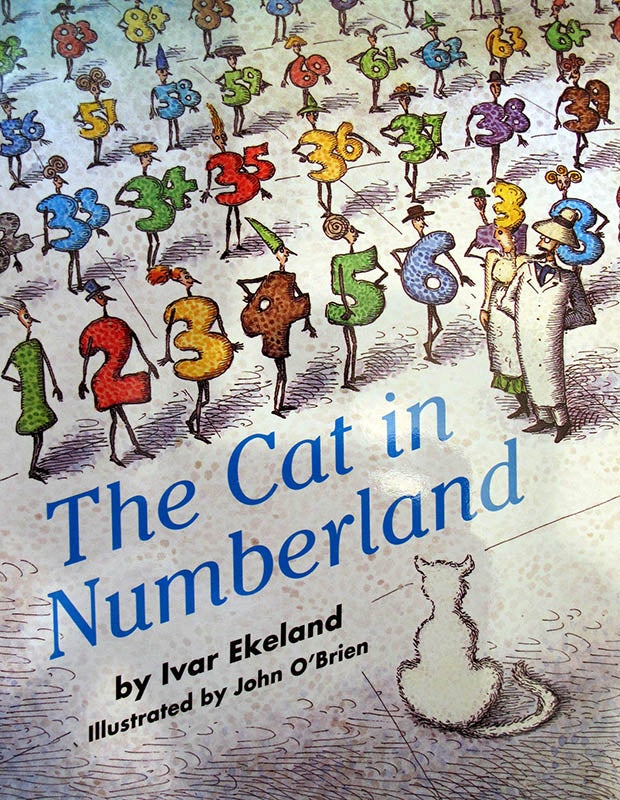The Venice Math Circle is an early math education program designed and directed by USC Mathematics Professor Sami Assaf to stimulate creative, analytical problem solving for young children through weekly meetings that turn deep mathematical concepts into child’s play. Using manipulatives such as blocks, dots, and dinosaurs, Professor Assaf guides kids to discover mathematical principles that lay the foundations for probability, computer science and physics. With a wide variety of thoughtfully designed mathematical games, kids will develop stronger number sense, improve their abstraction, learn to articulate and analyze logical arguments, and gain a love of mathematics in its most creative form.
As the goal of the Venice Math Circle is to stimulate creativity and analytical thinking, in the Circle we present instances of a mathematical principle or theorem, ask the children to look for patterns and then guess why those patterns arise. Precise explanations are not presented, because the goal is not for the students to try to guess the right answer. The goal is for the students to think up their own answer and justify it.
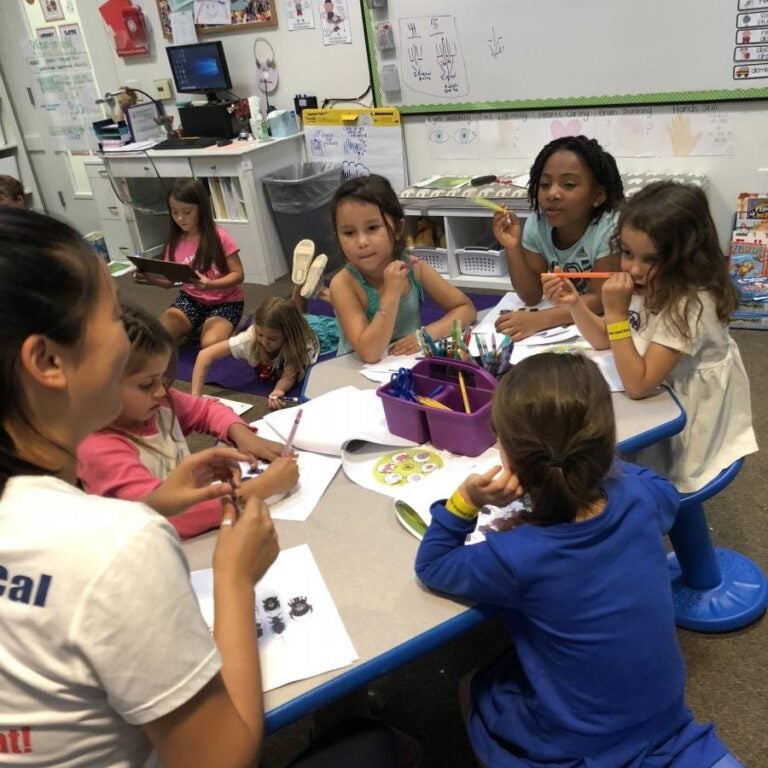

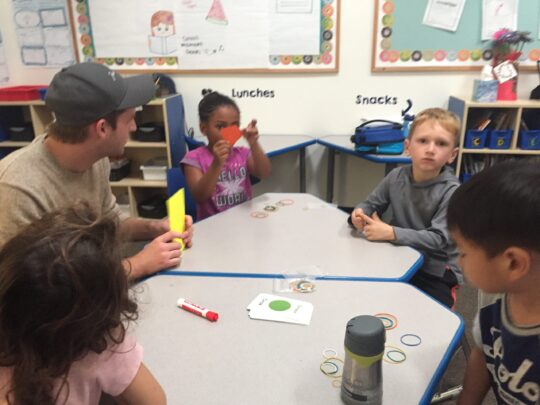

Preschool and Kindergarten
The main inspiration for our Pre-K to K class is Alexander Zvorkin’s parent journal from his experiments in running math circles for his own children. The book, Math from Three to Seven: The Story of a Mathematical Circle for Preschoolers, is as entertaining as it is instructive, and I highly recommend it for mathematically trained parents looking to start their own circle. Additional resources include the Natural Math book series and the text Breaking Numbers into Parts by Oleg Gleizer and Olga Radko, who organize the UCLA Math Circle.
-
We have many, many of these dinosaurs which come in six species and six colors (so how many possible dinosaurs are there?).
For this lesson, Sami selected a handful of dinosaurs and laid out two ropes formed into circles on the floor. First up, put all red dinosaurs in the red circle and all blue dinosaurs in the black circle. No problem! Second up, all triceratops in the red circle and all brontosauruses in the black circle. Easy peasy!
Then Sami asked the children to sort all of the red dinosaurs into one circle and all of the T-rex dinosaurs into the other. After a flurry of flying dinos, the children started to see the problem… where, oh where, should the red T-rex go? In the red circle since it’s red? In the T-rex circle since it’s a T-rex?
After much deliberation as to whether putting the red T-rex into either circle truly satisfied the objective, one child suggested the red T-rex had to go in the middle, between the two circles. The group was unsatisfied with this solution. Then another child suggested they move both circles until that red T-rex was inside of both, thus creating a Venn Diagram of dinosaurs. Everyone agreed this was the best solution.

Of course, we didn’t stop there. Sami next asked the children to count the number of red dinosaurs (4) and the number of T-rexes (4) and then asked, how many dinosaurs total? The children all agreed that there must be 4+4=8. So we counted. And got 7… interesting!
-
Boon makes wonderful bath toys, including a fleet of stackable boats
that come in handy for transporting dinosaurs across a scarf river, which was the main focus of the following activity.To begin, each child selected a boat and Sami asked them to assemble a “set” of three dinosaurs, in which two are the same color and two are the same species. Once each set was selected, we used two circles to test the solution, where one circle had both of the same color, the other both of the same species, and one dinosaur in the overlapping intersection. With passengers assembled, the boats lined up on one side of a flowing scarf and prepared to cross the river.
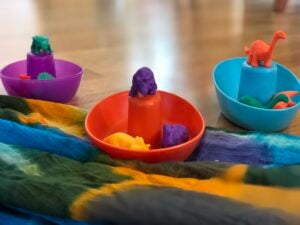
Round 1: At least one and at most two dinosaurs must be in the boat for every crossing. The children had no trouble puzzling this one out, and all dinosaurs made it to the shore with three crossings (two forward, one back).
Round 2: No two dinosaurs of the same color may ride in the boat together. After a couple turn-around trips across the sea, the captains sailed their dinosaurs safely across.
Round 3: No two dinosaurs of the same color or of the same species may ride in the boat together. This one took a fair amount of puzzling and some dinosaurs took an inevitable swim in the river, but in the end, the children mastered this colorful twist on the classic river crossing puzzle.
-
On this day we began with a story about a house with many stories (because no one is too young to appreciate puns).
Hermie is a precocious little girl who lives on the top floor of a nine story building. Each morning she rides the elevator all the way down to the first floor. Each evening she rides the elevator up to the fourth floor, then takes the stairs the rest of the way. How strange! Why does she do that?
Conjectures included a play date with a friend, a desire to run super fast up the stairs, and that she didn’t like the dog in the elevator. The story continued…
Several months later, Hermie rides down to the first floor in the morning, and rides up to the fifth floor before taking the stairs to the ninth in the evenings. What, oh what, is going on?
Conjectures again included the barking elevator dog, but now also that she was more tired than usual. So Sami had the kids come to the white board one at a time to try to push the red elevator buttons. They managed to push 5 just fine, but none could reach up to 9. The story ended with the riddle solved, but class was far from over.
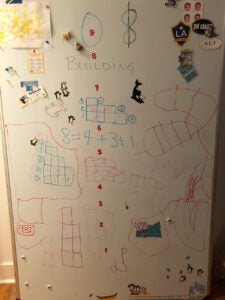
Sami gave each child two dozen wooden cubes, which we called “rooms”, and asked them to build houses with 4 rooms and 2 stories. We discovered that there were only 2 ways to do it. We counted the rooms by floor, 2+2 and 3+1, so we found two ways to add up two numbers to get 4. Then we moved on to how many different buildings we could make from 5 rooms with any number of floors, and we discovered there are exactly 7 integer partitions of 5 (once we left justified our rooms, of course).
Next up, how many buildings can we make from 8 rooms with exactly three stories? Some kids stuck with blocks on the floor with Sami, others took over the white board to draw buildings as Young diagrams with Sabrina, but everyone built masterpieces with exciting stories about who lives there and when they can have a play date with Hermie!
Third, Fourth, and Fifth Grades
Maintaining the strategy of learning through exploration, the organization of the Circle for the upper elementary grades shifts to 5-6 week sessions focusing on a common theme.
There’s plenty of room at the Hotel Infinity
Based on David Hilbert’s concept for understanding infinity as beautifully exposited by Ivar Ekeland in The Cat in Numberland, we construct Hilbert’s Hotel Infinity using blocks (but only finitely many) and labels so that we can manipulate infinity. Each week we begin with a read aloud of more of the story of Hotel Infinity and then solve a new problem while exploring parity, learning to solve for variables, and understanding linear orders.
Week 1 – “No biggest number” — in which we learn about Hotel Infinity and its guests, the Numbers
Week 2 – “Infinity plus one” — in which Zero arrives and we learn to make room where there was none before
Week 3 – “Infinity plus twenty-six” — in which we play new games with Letters and find more room
Week 4 – “Half of infinity” — in which the Odd Numbers leave and yet the hotel remains full
Week 5 – “Infinity times infinity” — in which the arrival of the Fractions creates a housing crisis
